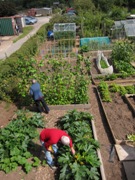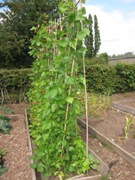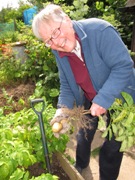Family garden allotments have been being used in England since the 1700s. Typically, a town council provides a tract of land and sets up an allotment association to manage the allotment and coordinate with the individual gardeners. During WW II Victory Garden days, families were given a 10 yard by 30 yard (today they are measured in meters) standard plot: large enough to provide vegetables for a family of 4.
 |
I have been able to visit two allotments in England over the past 10 days—one in Manchester—and one in Coventry. Today I will share my experience at David Wilkin’s allotment at the Wellington Road Allotments in the Fallowfield neighborhood of Manchester; David was kind enough to give me a tour of his allotment that he has been using for 9 years.
|
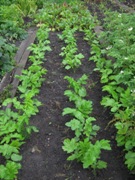 |
Originally farmland when the allotment started during the second world war, the area has since been fully developed with streets and houses—so the allotment occupies what is now a portion of a city block. On a street corner the size of 3 or 4 house lots, Fallowfield has 54 individual (10 x 30) allotments. Families pay a small monthly fee to the allotment association (typically around $5.00 per month).
|
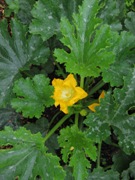 |
The first thing that I noticed was the look of permanence: Allotments all had sheds and many had greenhouses. There is even a central shed run by the association where one can warm up a lunch—or share a cup of tea with friends.
|
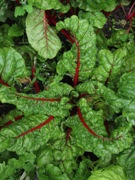 |
David runs his organic plot through a 3–year rotation: brassicas->potatoes->beans->onions. He feels that this helps him to maintain soil fertility and confuse insects.
His garden provides he and his family with vegetables late May through March. He plants a few fast growing vegetables several times a year in a succession—and he also plants early and late varieties of crops to spread his harvest through the year.
|
 |
In his greenhouse he raises:
Tomatoes
Eggplant
Melons
Peppers
Grapes
|
Crop List:
Fennell
Winter broccoli
Kale
Cabbage
Sweed
Red Cabbage
Spring Cabbage
Swiss Chard
Leeks
Parsnips
Zucchini (courgettes)
Beet root
Beet spinach
Carrots
Potatoes (Yukon Gold, Desiree, Pink Fir Apple)
Squash (4 types)
Broad beans
Runner Beans
Gooseberries
Onions
Challenges:
Two of his biggest challenges are pigeons which eat his brassicas (He covers the beds with green netting), carrot root fly (he covers the beds with Enviromesh—an air and water permeable sheet), and slugs.
Soil & Water
For soil and water conservation from September through May he uses a black fabric mulch—which lets water through—but reduces weed growth, evaporation and top-soil nutrient loss through erosion.
David double digs his raised beds, places horse manure in the bottom as he digs, and liberally applies compost which he makes.
All and all, David’s garden is bountiful and I was able to enjoy several wonder meals made from his garden harvest: 4 different vegetables at each meal including salads, root crops roasted with a bit of olive oil, and a wonderful English dessert–gooseberry fuul.
See David’s Allotment:
http://wiki.worldflicks.org/wellington_road_allotments.html
Next week we visit an allotment garden in Coventry England. This allotment is much larger than the allotment in Manchester and covers an area of 3 or 4 city blocks. They have 180 full allotments
Learn how to develop a community centered, impact oriented project.


